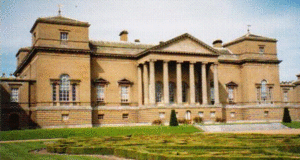English country house facts for kids
The English country house is a big, fancy home in the countryside. Usually, rich families who owned these houses also had another large home in London. These country houses were not just for weekend getaways for nobles; sometimes, they were the main home for less wealthy but still important families.
How English Country Houses Changed
English country houses have changed a lot over the last 500 years. Before this time, most large homes were like small castles. They were built to be strong and protected. This was because their owners were powerful lords who ruled over their lands.
During the Tudor period (from 1485 to 1603), England became more peaceful. Because of this, people started building large country houses that were not fortified. These new homes were designed for comfort and beauty, not for defense.
Later, with the rise of modern factories and cities, many people moved away from the countryside. This meant fewer people lived in the country, and country houses became less popular. After 1945, it became very hard for owners to pay for the many staff needed to keep these huge houses running. Many country houses were sold or even torn down because they were too expensive to maintain.
Images for kids
-
Longleat House was the first country house to open to the public. It also has the first safari park outside Africa.
-
Forde Abbey in Dorset. Many country houses grew over centuries. This one shows styles from medieval to Palladian and even Strawberry Hill Gothic.
-
Kedleston Hall in Derbyshire, designed by Matthew Brettingham and Robert Adam, is a very grand house.
-
Waddesdon Manor, Buckinghamshire. In the Victorian era, rich business owners built huge country houses in many different styles.
-
Trentham, Staffordshire. In the 1900s, thousands of country houses were torn down. Their parts were often sold, and many beautiful features went to the US.
See also
 In Spanish: Country house para niños
In Spanish: Country house para niños










